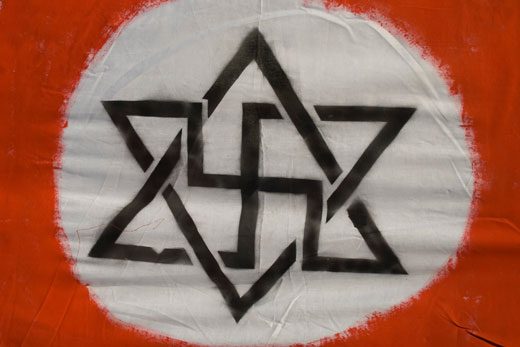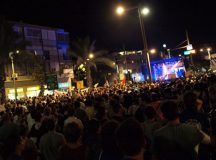One of the cruellest aspects of the new antisemitism is its perverse use of the Holocaust as a stick to beat ‘the Jews.’ Lesley Klaff explains the phenomenon of ‘Holocaust Inversion.’
In 2013 the Liberal Democrat MP for Bradford East, David Ward, after signing the Book of Remembrance in the Houses of Parliament on Holocaust Memorial Day, made use of the Holocaust to criticise Israel and ‘the Jews’ by equating Israel with Nazi Germany, and to characterise the Holocaust as a moral lesson from which ‘the Jews’ have failed to learn. He wrote, ‘Having visited Auschwitz twice – once with my family and once with local schools – I am saddened that the Jews, who suffered unbelievable levels of persecution during the Holocaust, could within a few years of liberation from the death camps be inflicting atrocities on Palestinians in the new state of Israel and continue to do so on a daily basis in the West Bank and Gaza.’
What has been called ‘Holocaust Inversion’ involves an inversion of reality (the Israelis are cast as the ‘new’ Nazis and the Palestinians as the ‘new’ Jews), and an inversion of morality (the Holocaust is presented as a moral lesson for, or even a moral indictment of ‘the Jews’). More: those who object to these inversions are told – as they were by David Ward – that they are acting in bad faith, only being concerned to deflect criticism of Israel. In short, the Holocaust, an event accurately described by Dan Diner as a ‘rupture in civilisation,’ organised by a regime that, as the political philosopher Leo Strauss observed, ‘had no other clear principle except murderous hatred of the Jews,’ is now being used, instrumentally, as a means to express animosity towards the homeland of the Jews. ‘The victims have become perpetrators’ is being heard more and more. That is Holocaust Inversion.
The inversion of reality and morality
Clemens Heni, the German political scientist and director of the Berlin International Center for the Study of Antisemitism (BICSA), believes that the equation of Israel/the Jews/Zionism with Nazism amounts to an ‘inversion of truth’ which is used today as a form of ‘extremely aggressive anti-Jewish propaganda.’ Anthony Julius, author of a landmark study of British antisemitism, notes that Holocaust Inversion is becoming part of the iconography of a new antisemitism. Headlines such as ‘The Final Solution to the Palestine Question,’ references to the ‘Holocaust in Gaza,’ images of IDF soldiers morphing into jackbooted storm troopers, Israeli politicians morphing into Hitler, and the Star of David morphing into the Swastika, are all increasingly common.
The 2009 Report of the European Institute for the Study of Contemporary Antisemitism,Understanding the ‘Nazi’ Card: Intervening against Anti-Semitic Discourse, reported that equating Israel with the Nazis is an important component of incitement and racial aggravation against Jews in the UK today. The Report recommended that the Home Office, the Association of Chief Police Officers, and the Crown Prosecution Service prepare guidance for the police on whether the use of Holocaust imagery to refer to contemporary Israeli policy amounts to incitement of racial hatred against Jews.
Comparing Israel and the Nazi regime, David Ward said, ‘don’t forget, long before the death camps were set up, the treatment of the Jews in … Nazi Germany was racist … nastiness and harassment to begin with, and then escalated. And when you look at it – wherever it may be – the West Bank, and a declared intent by the Israeli forces to harass, often just annoy Palestinians – in terms of a check point that will be open on certain days, and then it will be open but at a later time, and the next day, it will open slightly earlier, so you get there and it’s been shut again … really just to harass, in many cases to move the Palestinians from land, to just give up and move on…’
Now, whether or not IDF soldiers deliberately change the opening and closing times of check points in the West Bank in order to harass Palestinians, I do not know; but even if they do, no matter how wrong that would be, there is absolutely no equivalence betweenthat and the denial of paid work, Jew-baiting, herding into ghettos, incarceration, disease and starvation in labour camps that occurred in Germany and Eastern Europe between 1933 and the Holocaust. Not only is there no historical equivalence between the two; there is no moral equivalence either.
he historian Deborah Lipstadt – author of Denying the Holocaust: The Growing Assault on Truth and Memory and successful defendant in the libel suit brought against her and Penguin Books by the Holocaust denier David Irving – has used the term ‘soft-core denial’ to highlight the damage done by Holocaust inversion. The false equivalencing of Israel and the Nazis, she says, ‘elevates by a factor of a zillion any wrongdoings Israel might have done, and lessens by a factor of a zillion what the Germans did.’ And as Anthony Julius points out, the Zionist=Nazi trope not only says to the world that the ‘Zionists are to the Palestinians what Nazis were to the Jews’, but also that ‘the “Zionists” and Nazis share the same Fascist ideology’ and that ‘the “Zionists” were complicit with the Nazis in the Holocaust.’
The ‘anti-Zionist’ writers, Hazem Saghiyah and Saleh Bashir published an article in 1998,Universalizing the Holocaust, which makes clear the moral inversion involved in the Holocaust Inversion. ‘The dissociation between the acknowledgment of the Holocaust and what Israel is doing should be the starting point for the development of a discourse which says that the Holocaust does not free the Jewish state or the Jews of accountability. On the contrary, the Nazi crime compounds their moral responsibility and exposes them to greater answerability. They are the ones who have escaped the ugliest crime in history, and now they are perpetrating reprehensible deeds against another people.’
Holocaust Inversion, then, involves the abuse of the Holocaust memory to issue a moral stricture aimed at Israel and ‘the Jews’, imposing upon them a uniquely onerous moral responsibility and accountability in their treatment of others.
The accusation of ‘bad faith’
Criticised for his Holocaust Memorial Day comments, David Ward hit back by accusing his critics of bad faith: ‘There is a huge operation out there, a machine almost, which is designed to protect the State of Israel from criticism. And that comes into play very, very quickly and focuses intensely on anyone who’s seen to criticise the State of Israel. And so I end up looking at what happened to me, whether I should use this word, whether I should use that word – and that is winning for them.’
This is an example of ‘The Livingstone Formulation’, a term coined by David Hirsh to refer to the practice of responding to claims of contemporary antisemitism by alleging that those making the claim are only doing so to prevent Israel from being criticised; in other words, they are ‘playing the antisemitism card.’ Ward’s statement is a perfect illustration of the Livingstone Formulation because while Ward claims that an ad hominem attack is being made on him by a ‘huge operation out there, a machine almost,’ it is, in fact, he who is making an ad hominem attack on those who question him. Rather than a ‘huge operation’ deflecting criticism of Israel, it is actually Ward who is deflecting legitimate concerns about antisemitism in the form of the Holocaust inversion.
By inverting reality and morality, and by recklessly spreading accusations of bad faith, Holocaust Inversion prevents us identifying the changing nature of contemporary antisemitism and is an obstacle to marshalling active resistance to it.
Further Reading
Robert Fine (2009) ‘Fighting with phantoms: a contribution to the debate on antisemitism in Europe’, Patterns of Prejudice 43 (5); Manfred Gerstenfeld (2007) ‘Holocaust Inversion: The Portraying of Israel and Jews as Nazis’, Jerusalem Center for Public Affairs, 55; Clemens Heni (2008) ‘Secondary antisemitism: from hard-core to soft-core denial of the Shoah’, Jewish Political Studies Review, 20 (3-4); David Hirsh (2010)‘Accusations of malicious intent in debates about the Palestine-Israel conflict and about antisemitism’, Transversal; Paul Iganski and Abe Sweiry (2009) Understanding the ‘Nazi Card’: Intervening Against Anti-Semitic Discourse, Report of the European Institute for the Study of Contemporary antisemitism; Anthony Julius (2010) Trials of the Diaspora: A History of Antisemitism in England.






































Interesting to read this in the light of the annexation of polan – mean the West Bank – isn’t it?
Looks like Dave had a point.